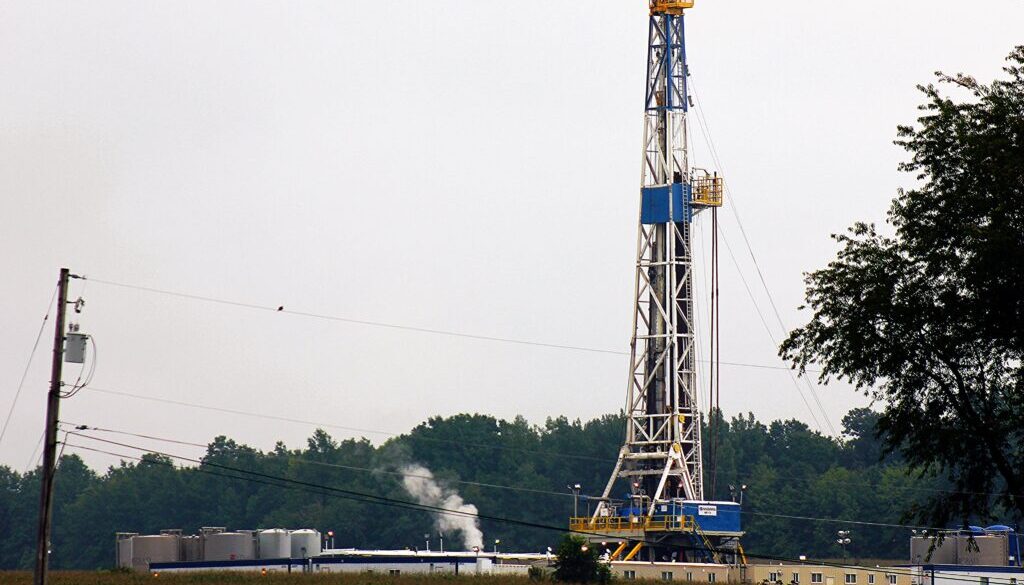Risks of fracking are “real and growing,” report warns
By Dana Drugmand
The human and environmental health risks associated with hydraulic fracturing, commonly known as fracking, are “real and growing,” according to a new report synthesizing nearly a decade of research.
The Fracking Science Compendium, ninth edition was released in October by Concerned Health Professionals of New York and Physicians for Social Responsibility, and adds to evidence of numerous problems posed by natural gas extraction through fracking and fracking-associated infrastructure, from pipelines and compressor stations to appliances such as gas furnaces and stoves. The report compiles data and conclusions from thousands of studies, including peer-reviewed papers, investigative media reports and government documents.
“Our examination uncovered no evidence that fracking can be practiced in a manner that does not threaten human health directly or without imperiling climate stability upon which human health depends,” the report states.
For years, scientists have warned that living in close proximity to a fracking operation elevates one’s risk of developing various diseases or health impairments, and the science substantiating these exposure-based outcomes has only gotten more robust over the years.
“This rapidly growing body of hundreds of studies supports the conclusion that fracking causes a variety of adverse health effects in fetuses, infants, children, and adults,” Dr. Ted Schettler, a retired physician and public health expert and science director of the Science and Environmental Health Network, said in a webinar held this week to discuss the report results.
Schettler said several studies have found that children living near fracking sites are more likely to be diagnosed with cancer. One recent study for example found that children whose birth residence was within 2 kilometers of a fracking well were 2 to 3 times more likely to be diagnosed with acute lymphoblastic leukemia between the ages of 2 and 7 than children living further away.
Exposure to fracking and associated infrastructure has also been linked to preterm birth, reduced birth weight and birth defects, increases in asthma attacks and respiratory diseases, cancers, heart attacks and heart failure, and premature death, among other adverse outcomes. Fracking inherently uses and generates toxic chemicals, many of which are not required to be disclosed, and these toxins contaminate air, water, and soil. Benzene and formaldehyde, fine particles, nitrogen oxides, and chlorine are among some the chemicals that have been detected at drill sites.
Additionally, hazardous air pollution is infiltrating residential homes that are equipped with gas heating and appliances. Research shows that using gas stoves, especially in the absence of adequate ventilation, increases exposure to harmful chemicals such as nitrogen oxides, carbon monoxide, and benzene. About 1 in 8 cases of pediatric asthma in the US is attributable to exposure to indoor air pollution from gas stoves.
Kathy Nolan, a pediatrician and president of the New York chapter of Physicians for Social Responsibility, said people should replace gas stoves in their homes as a preventative health measure, similar to quitting smoking or prohibiting smoking indoors.
“We have to wean ourselves off of natural gas,” she said.
Transitioning away from gas is also necessary from a climate standpoint. Contrary to the narrative that gas is a cleaner substitute for coal or is a “bridge fuel” to renewable energy, more evidence is emerging indicating that this fossil fuel has a larger greenhouse gas footprint than was previously understood. The main reason for this is that natural gas is almost entirely composed of methane, which is itself a powerful greenhouse gas that is roughly 86 times more potent than carbon dioxide over a 20-year timeframe. In fact, scientists estimate about 40% of current warming stems from atmospheric methane buildup.
“Shale gas has a greenhouse gas footprint that is certainly as big as that of coal,” said Robert Howarth, a professor of ecology and environmental biology at Cornell University and a leading expert on the greenhouse gas impacts of fracked gas. In 2011 Howarth and colleagues published the first peer-reviewed analysis examining the climate consequences of fracked gas, finding that because there are methane leaks and venting throughout the lifecycle, shale gas is likely to be a significant contributor to global warming.
The peer-reviewed science since then has further validated their finding, and Howarth has now issued a new warning about the greenhouse gas emissions impact of liquified natural gas (LNG). In a paper just submitted for peer review, Howarth analyzed the emissions associated with LNG export operations, which involves supercooling gas to liquefy it and then transporting it on giant tankers. His analysis shows that LNG carried by older-style tankers amounts to a greenhouse gas footprint that is roughly 2.5 to 3 times worse than simply burning coal, and even with the newest tankers it is still almost 25% worse than coal.
“The science is quite clear. Liquified natural gas is a terrible idea from a climate standpoint,” Howarth said.
This new analysis comes at a critical time when the US is rapidly expanding its LNG export capacity, driven at least in part by energy security concerns and energy policy decisions stemming from Russia’s invasion of Ukraine. The US currently has eight existing LNG export terminals with five more under construction and 17 others planned, 11 of which have received federal approval. Already the world’s number one exporter of natural gas and of liquified natural gas, the US is set to double its LNG export capacity over the next five years.
“When it comes to fracked gas, the United States is the fentanyl dealer to the planet,” biologist and senior scientist at the Science and Environmental Health Network Sandra Steingraber said during the briefing webinar.
Steingraber, who has been an instrumental contributor to the Compendium since its inception and referred to it as her life’s “most meaningful work,” emphasized that the detrimental impacts of this industry cannot be mitigated through existing regulations or controls.
“The problems with fracking, both for our health and for our climate, are intractable and are not fixable through any regulatory framework,” she said. “In this, fracking resembles lead paint or indoor smoking. No rules or regulations can make these practices safe.”
The only meaningful solution, the Compendium contends, is a comprehensive ban on fracking.
“The conclusion of the authors of the Compendium,” Nolan said, “is if you can’t do it safely, which we cannot, then we shouldn’t be doing it.”
(Featured photo by Brad Weaver on Unsplash.)
 EWG
EWG


